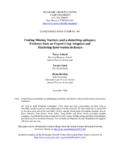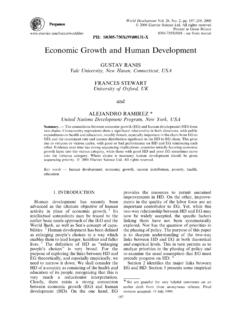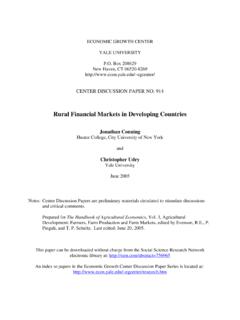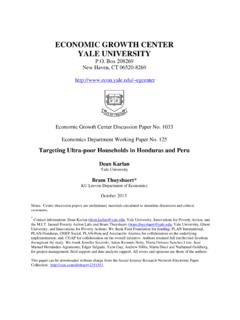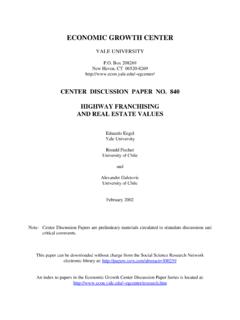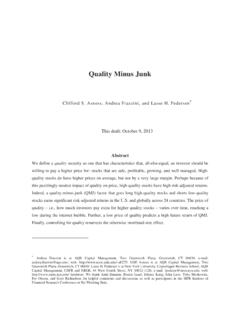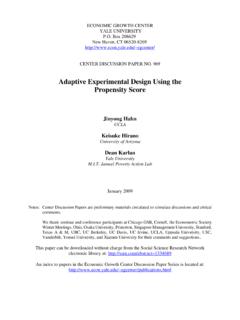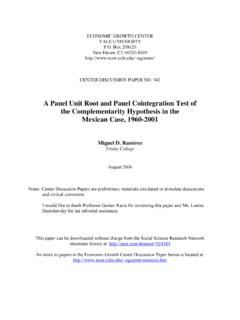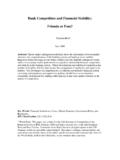Transcription of Hedging Real-Estate Risk - Yale University
1 1 Property Derivatives for Managing European Real-Estate Risk Frank J. Fabozzi is Professor in the Practice of Finance, Yale School of Management, New Haven, CT Robert J. Shiller is Arthur M. Okun Professor of Economics, Yale University , New Haven, CT Radu Tunaru is Senior Lecturer in Financial Mathematics, Cass Business School, City University , London 2 Property Derivatives for Managing European Real-Estate Risk Abstract Although property markets represent a large proportion of total wealth in developed countries, the Real-Estate derivatives markets are still lagging behind in volume of trading and liquidity. Over the last few years there has been increased activity in developing derivative instruments that can be utilised by asset managers. In this paper, we discuss the problems encountered when using property derivatives for managing European Real-Estate risk.
2 We also consider a special class of structured interest rate swaps that have embedded Real-Estate risk and propose a more efficient way to tailor these swaps. Keywords: Real-Estate markets, property derivatives, balance guaranteed swaps JEL classification: G15, G20 3 1. Introduction The property market represents the largest market in developed countries in Europe and the world, estimated between 30% and 40% of the value of all the underlying physical capital. From a theoretical perspective, residential Real-Estate assets are viewed as a combination of a consumption asset and a leveraged investment. A decade ago Shiller and Weiss (1999) pointed out that this very characteristic poses greater risk for the financial stability for households due to geographic fluctuations in property prices. Clearly, this prediction was realized in the residential real estate market beginning in 2007.
3 Moreover, consequences were not limited to the Real-Estate market but were felt in the market for other financial assets throughout the world. Ideally, property derivatives on some relevant Real-Estate indices could be used to mitigate Real-Estate risk and potential reduce the volatility of property prices. Although Real-Estate derivatives should be preferred to insurance-type contracts because of direct settlement, the liquidity of property derivatives is key to their utilisation by individuals and professional asset managers. However, liquidity can be established only after banks decide to participate more actively in the Real-Estate index futures and options markets, as suggested by Case, Shiller, and Weiss (1993). Hinkelman and Swidler (2008) investigated if housing price risk can be hedged with futures on other commodities and financial indices that already trade in the markets.
4 They could not find significant evidence of a systematic relationship between national housing prices and prevailing traded futures contracts. Hence, establishing property futures markets would help to complete the Real-Estate markets. Today it is well known now that housing prices are sticky when they are going down, sellers being reluctant to sell at a price below the psychological price at which the property was initially purchased, as first noted by Case, Quigley, and Shiller (2003). This makes the 4 market more localized, with information asymmetric, and participants price expectations strongly influenced by the most recent series of prices. It is less likely, at least for now, that a significant fraction of individual homeowners will hedge directly their house prices. Nevertheless, banks and building societies holding mortgage portfolios more diversified nationally have an incentive to hedge their exposure with property derivatives where the underlying is a local index.
5 The use of index-based futures contracts and options for Hedging mortgage risk, default risk, and Real-Estate price risk has long been advocated by Case and Shiller (1996). Fisher (2005) provides an overview of total return swaps activity in the United States while Clayton (2007) discusses several indices utilised for derivatives trading. The introduction of derivatives in the Real-Estate market is not easy because, as noted earlier, liquidity is difficult to establish when returns are predictable. An extensive discussion highlighting the important psychological barriers that need to be passed for the establishment of Real-Estate derivatives is provided in Shiller (2008). Carlton (1984) argues that if changes in market prices are predictable, then changes in prices cannot be perceived as risky. One major obstacle hindering the introduction and development of Real-Estate derivatives was the fact that when returns follow trends at certain points in time, the market sentiment is unidirectional, making it is difficult to find counterparties.
6 Nevertheless, we argue in the paper that if a futures contract is already trading for a series of future maturities, then the shape of the forward curve on Real-Estate index becomes important. Trades may be executed on the curve, trading simultaneously say short a futures with a long maturity and long a futures with a shorter maturity. Thus, a counterparty in a property derivatives contract does not have to be necessarily a speculator in order to take a position against a market trend. With futures and options on futures, an entire spectrum of trading strategies becomes available and market participants such as hedge funds, investment houses, and private equity funds may 5 provide much needed liquidity. For example, Alpha Beta Fund Management (ABFM), an open-end investment company based in Ireland does not invest directly in physical property assets but instead seeks more efficient means for accessing Real-Estate index returns.
7 The firm targets pension funds and other investors that may benefit from access to British housing by dealing in an over-the-counter property derivatives market which tracks the Halifax House Price Index (HHPI). The exponential growth of the subprime mortgage market from 2002 to 2007 was driven by the use of securitization as a process of ring-fencing the risks of a collateral portfolio on one side and the introduction of the Real-Estate collateralized debt obligation (RE CDO) concept on the other The ever-growing demand for credit risky bonds pushed the boundaries of this new structured credit market into new territory, residential mortgage-backed securities (RMBS) backed by home equity loans ( , loans to credit impaired borrowers) and commercial mortgage-backed securities (CMBS). The cash flows of a RMBS, CMBS, and RE CDO depend fundamentally on the performance of a pool of mortgage loans, which in turn depend on the behavior of individual homeowners and commercial borrowers.
8 These Real-Estate structured products are radically different from a corporate CDO where the collateral consists of corporate credits whose corporate names could be monitored and their balance sheet scrutinized regularly. Hence, the Real-Estate risk drivers prepayments and defaults clustering and timing as well as recovery rates, could influence the financial stability of companies and institutions not directly related to the spot Real-Estate market. Hedging the potential disruption of scheduled cash flows is not an easy task and there are only a few instruments available in the market. The advances in futures markets on Real-Estate indices may improve efficiency in spot markets and improve price discovery. Since transaction costs are high and create a barrier for 1 RE CDOs are also known as structured finance CDOs.
9 6 entry into spot markets, futures markets may also help indicate the level of spot prices for future and current market volatility. Another benefit of Real-Estate derivatives is that they are useful tools that allow investors access to an important asset class that would be hard to access otherwise. Indeed, the capital asset pricing model (CAPM) has as a fundamental results that investors should be holding all risky assets in proportion to the amounts outstanding, which suggests that real estate should be a major element in all portfolios involving risky assets. Furthermore, due to the lack of correlation of housing prices with equity prices, expanding diversified portfolios to include real estate could be highly beneficial, particularly for those who do not now invest significantly in a diversified portfolio of real estate , including many insurance companies and pension funds.
10 A further of this benefit is provided by Webb, Curcio, and Rubens (1988) and Seiler, Webb, and Myer (1999). In addition, Englund, Hwang, and Quigley (2002) point out that there could be large potential gains from instruments that would allow property holders to hedge their lumpy investments in housing. Obviously, the first step in Hedging is the selection of a suitable Hedging instrument. A primary factor in deciding which derivative contract will provide the best hedge is the degree of correlation between the factors that drive the price of the derivative instrument under consideration as the Hedging vehicle and the underlying risk which investors seek to eliminate. Correlation is not, however, the only consideration when the Hedging program is of significant size. If, for example, an investor wants to hedge a very large cash position, liquidity becomes an important consideration and it might be necessary to split the hedge among two or more different types of derivatives.
